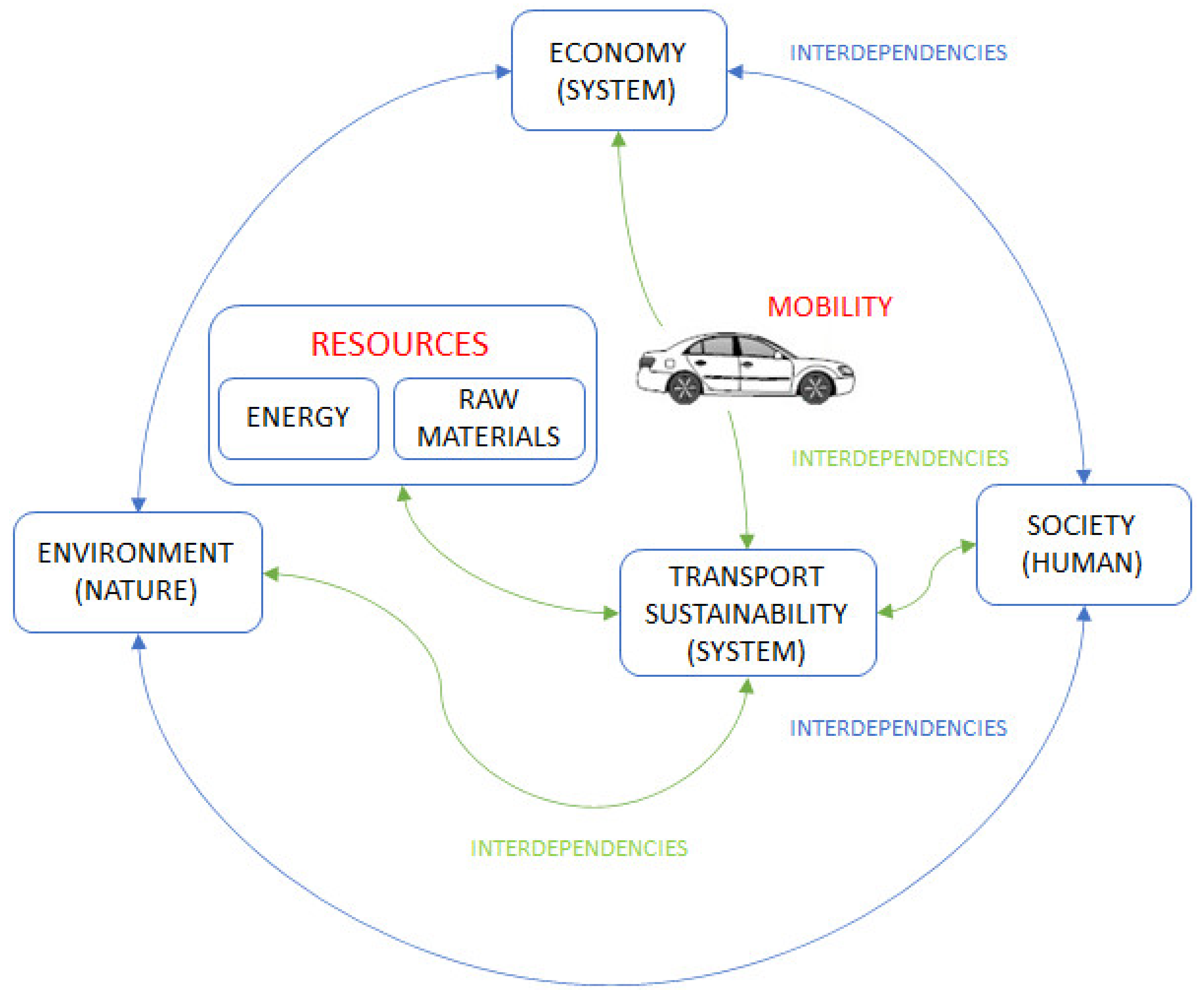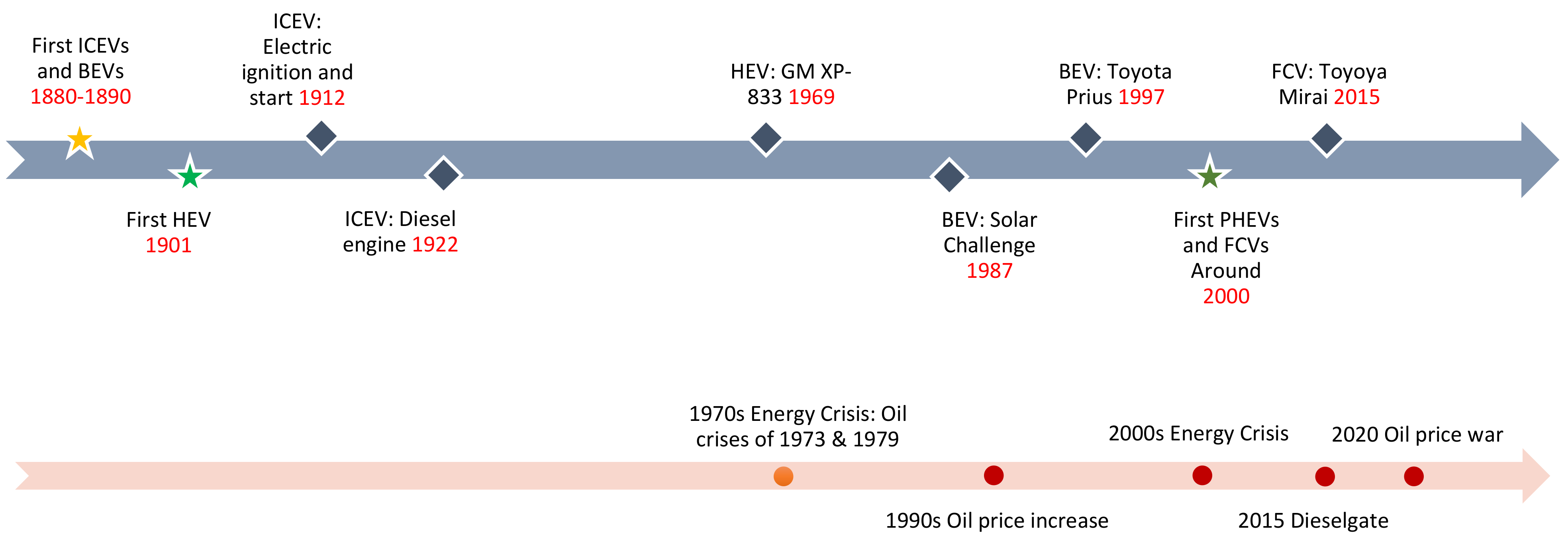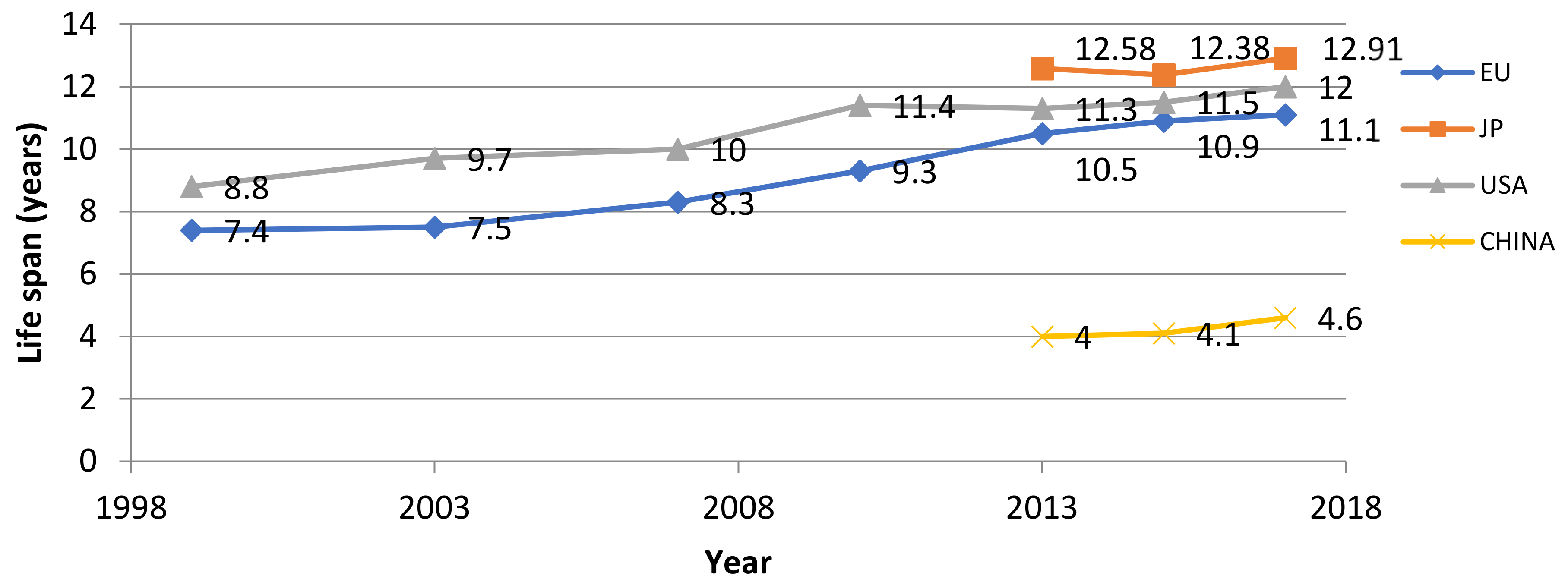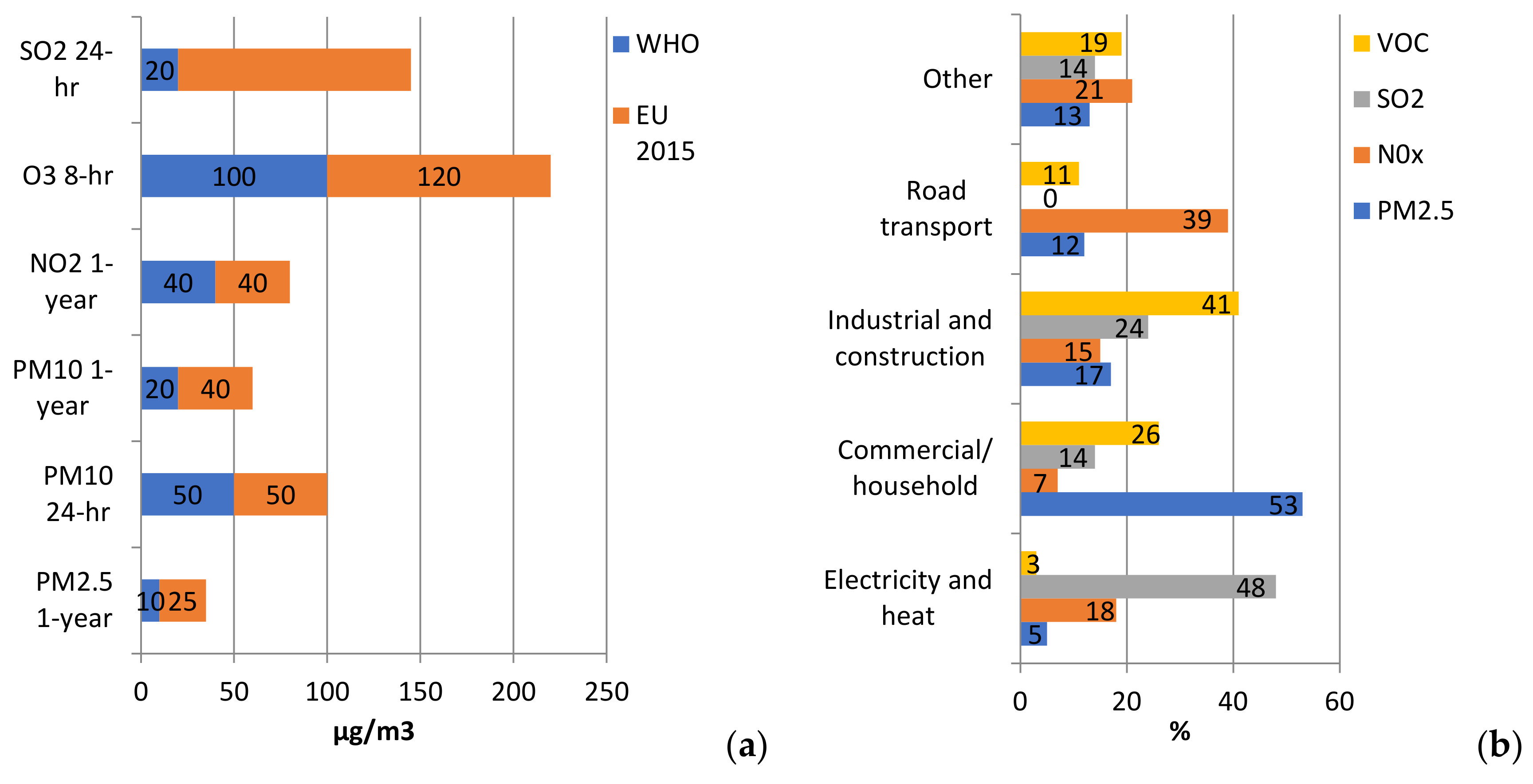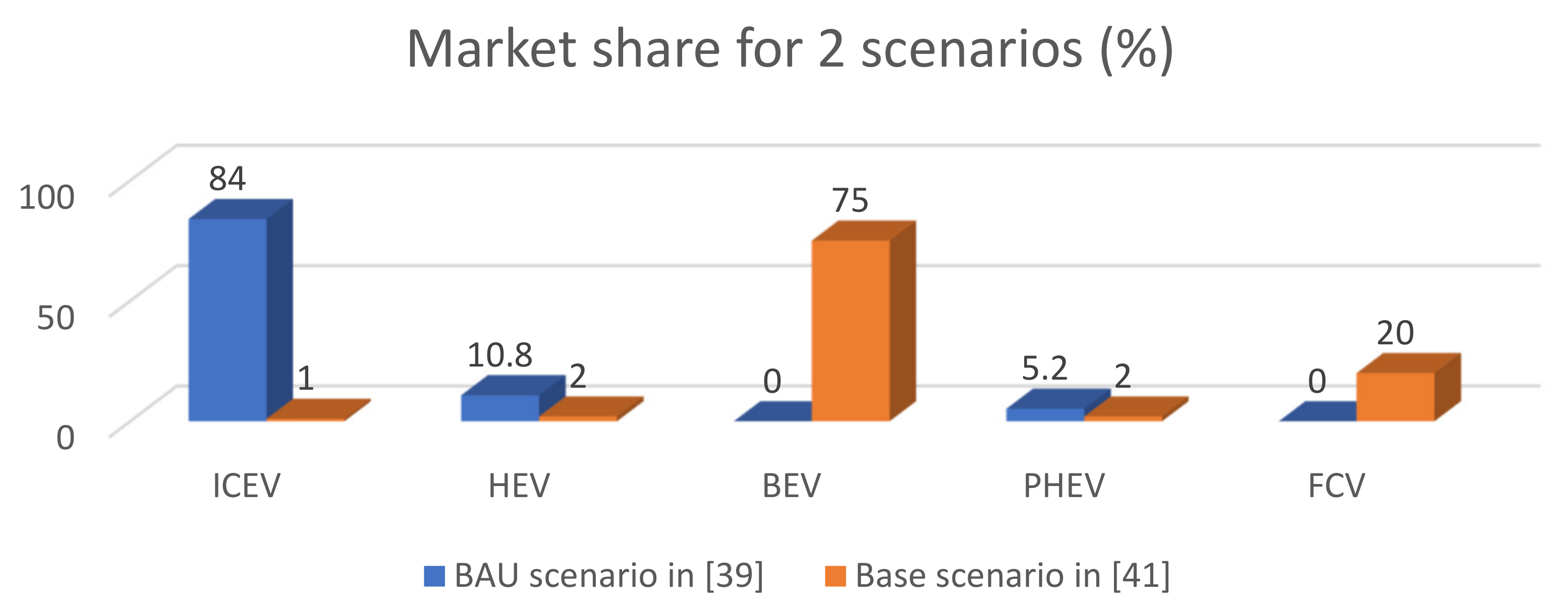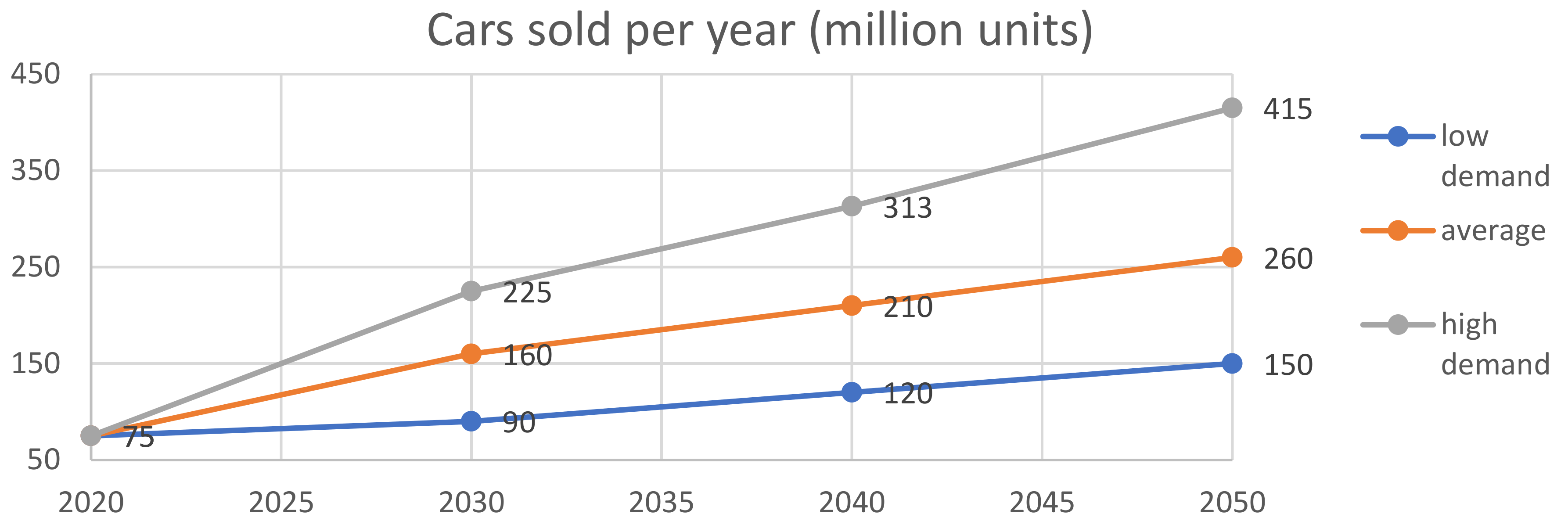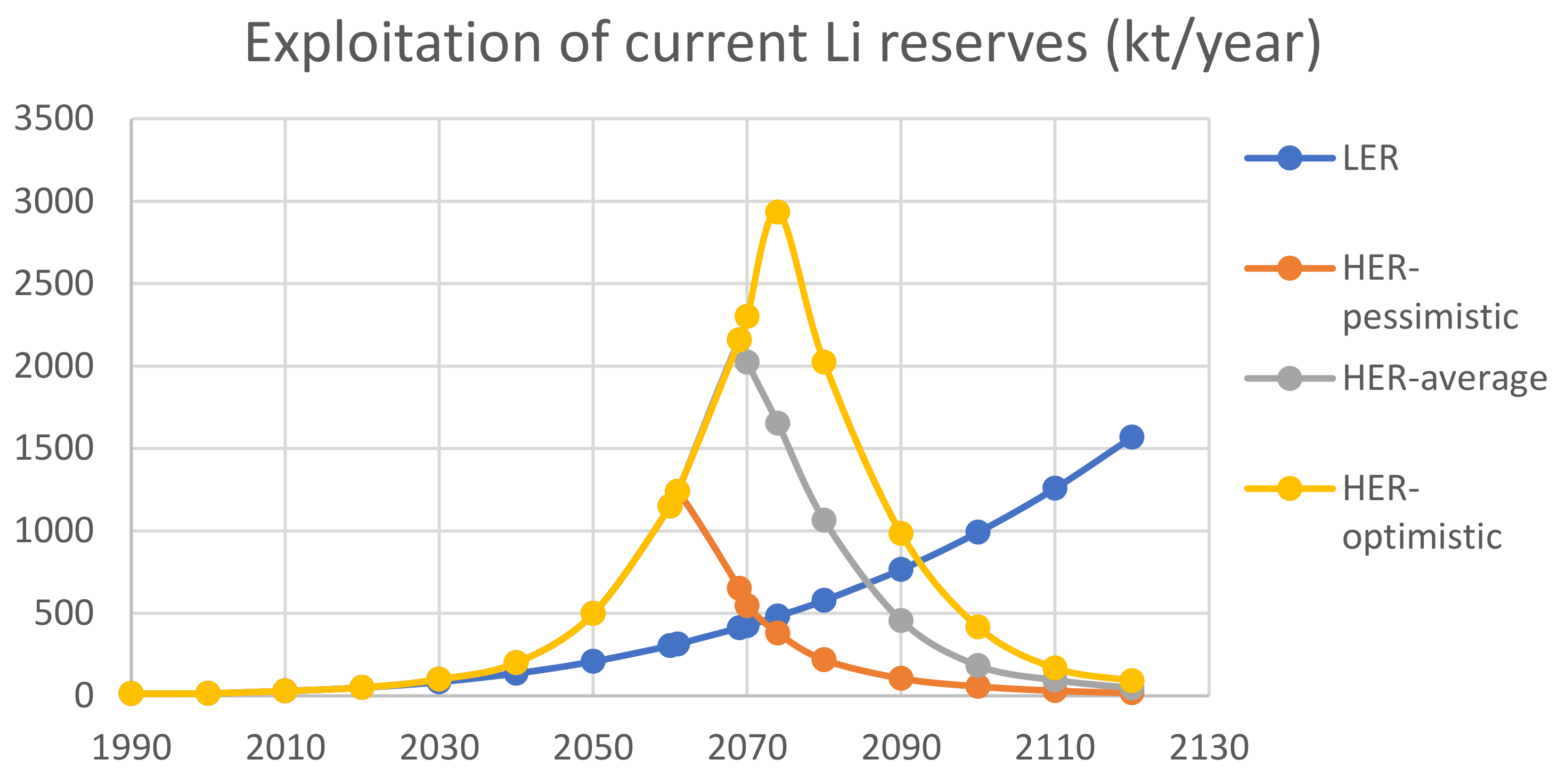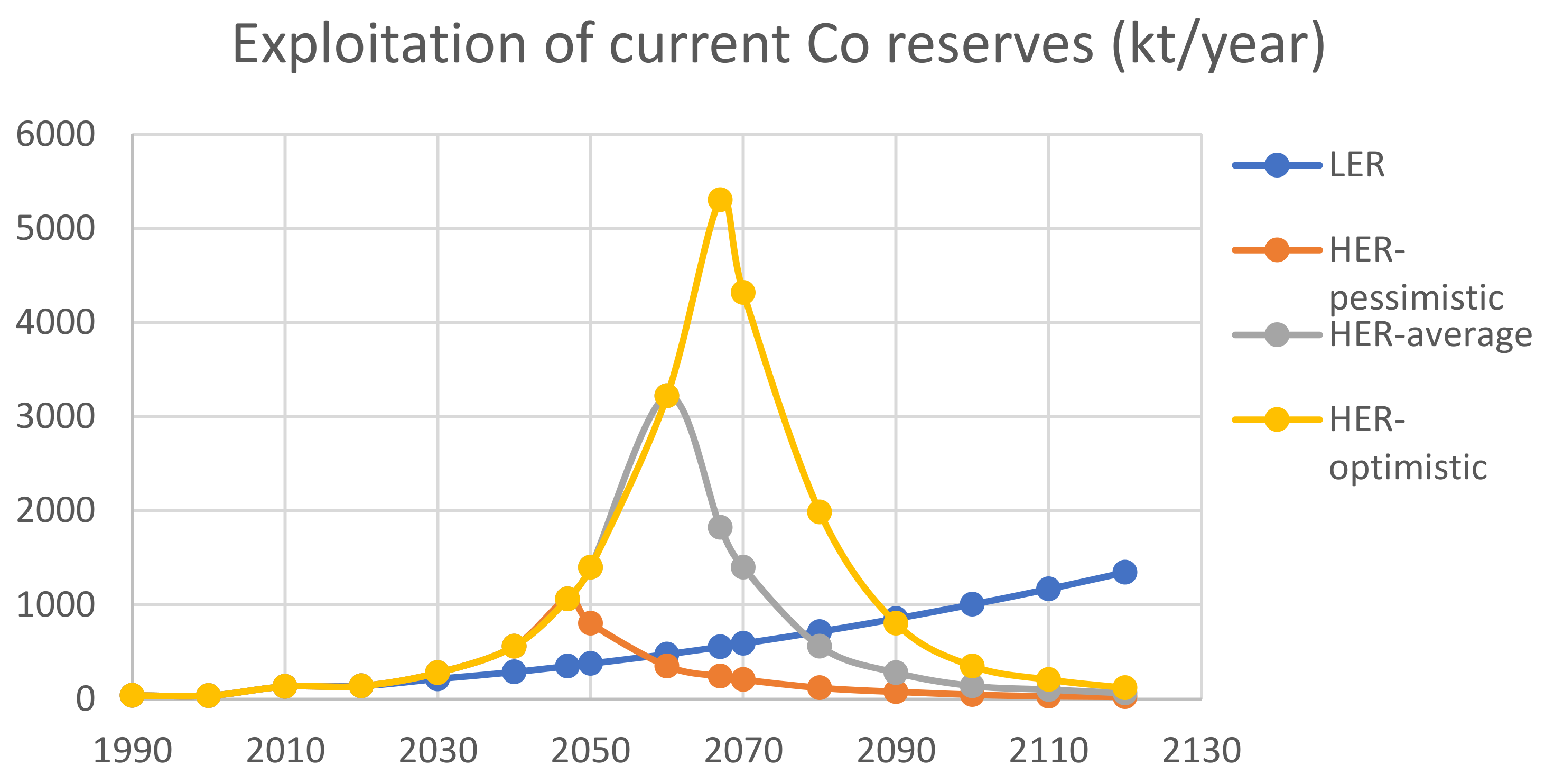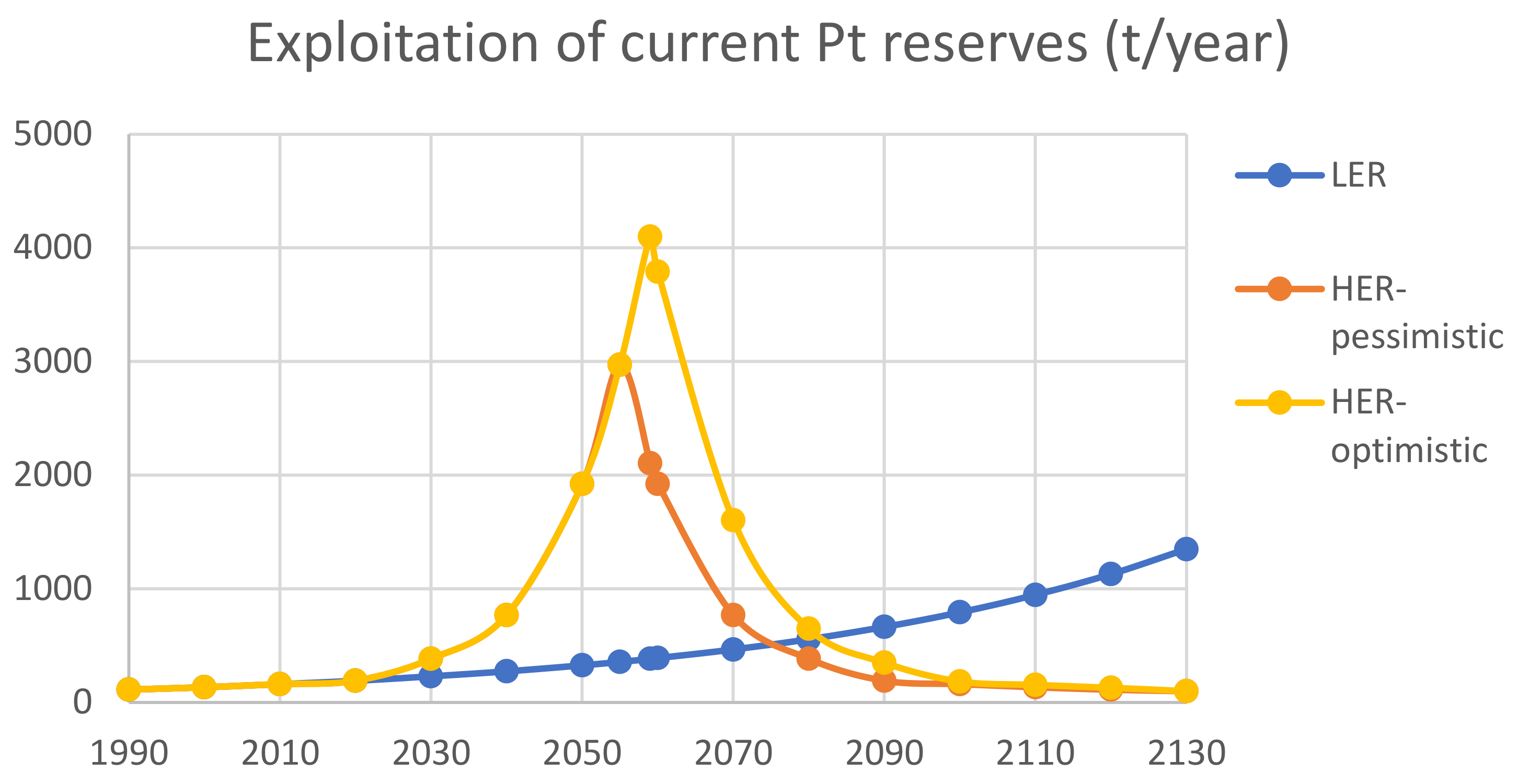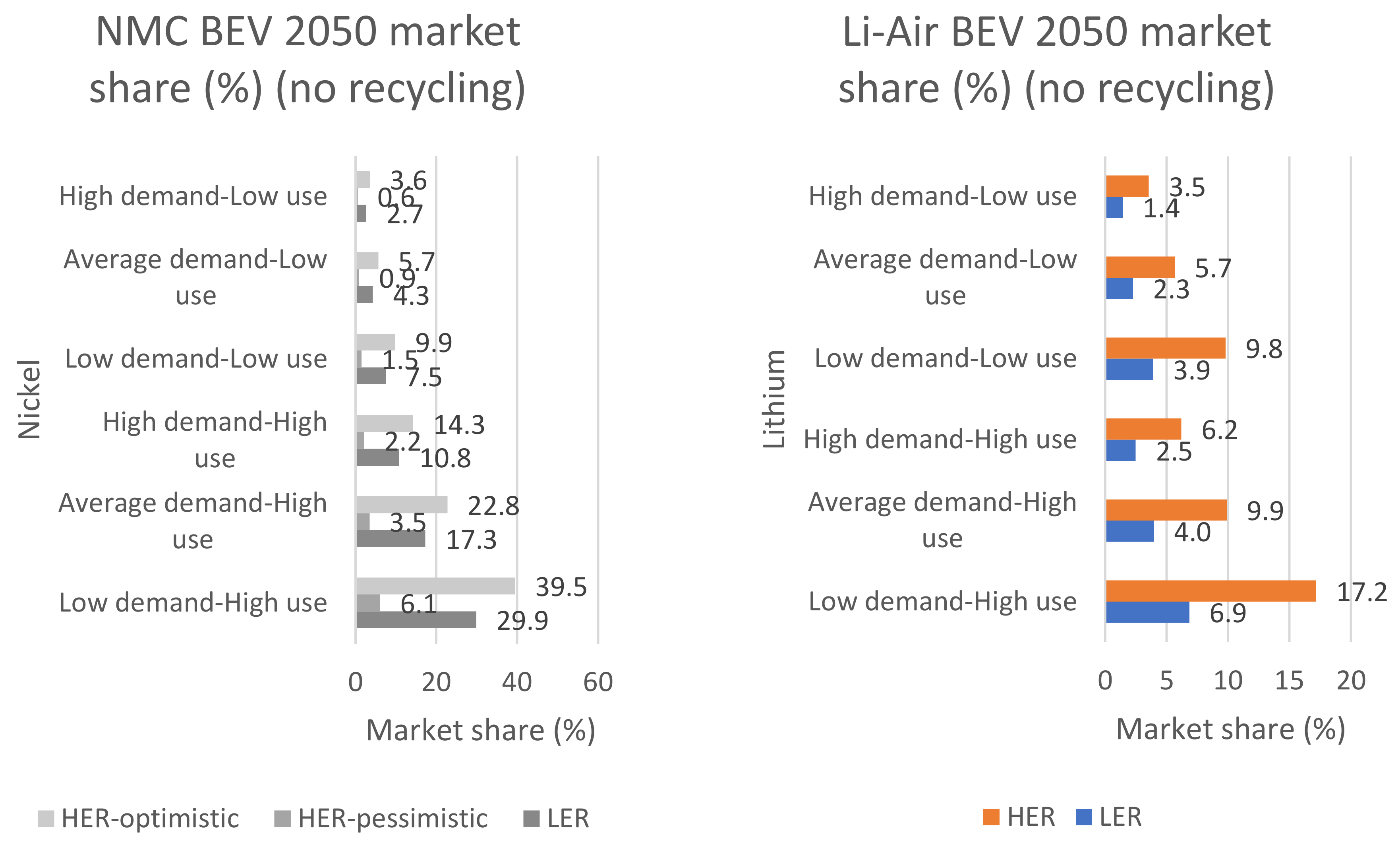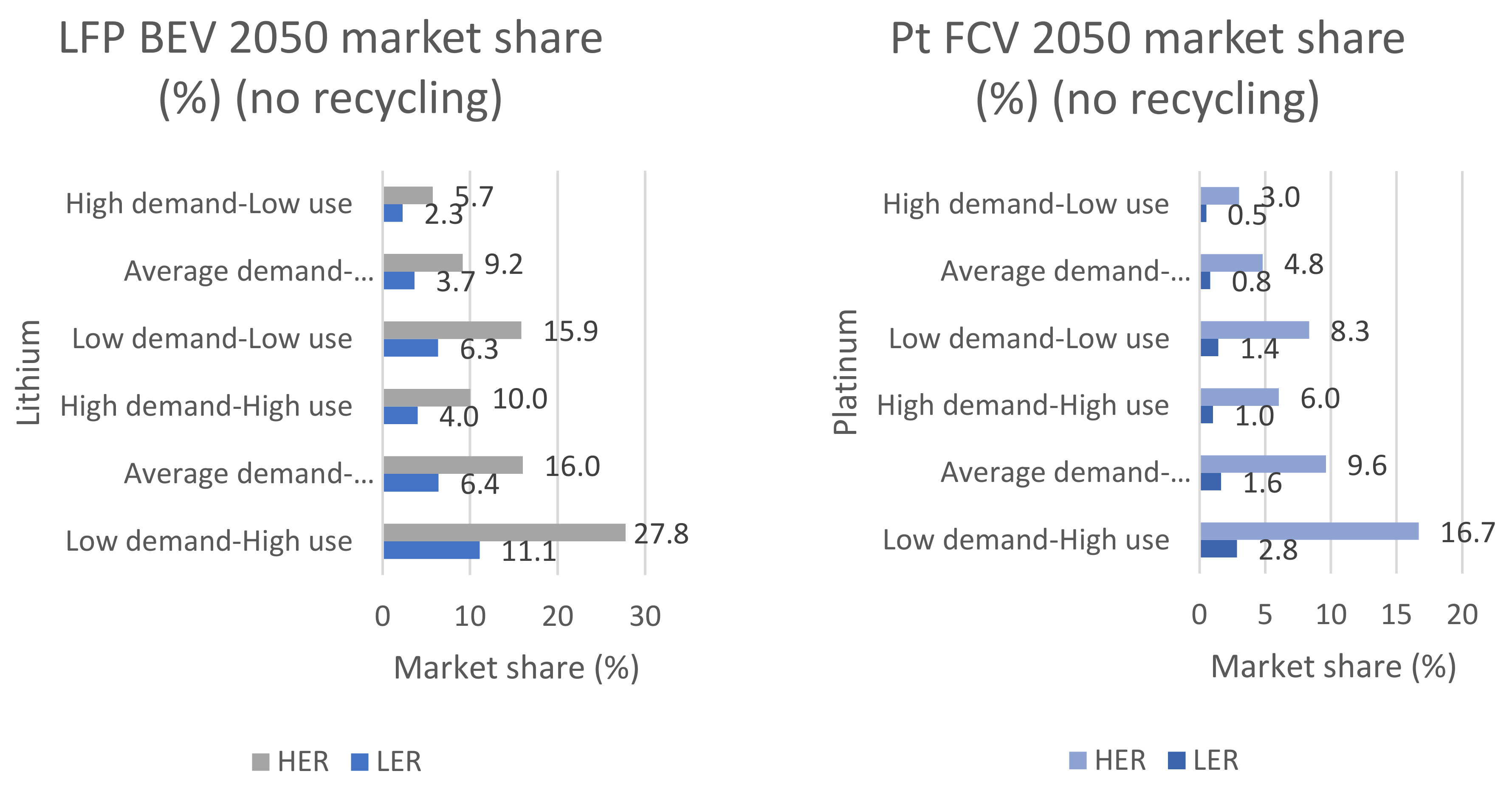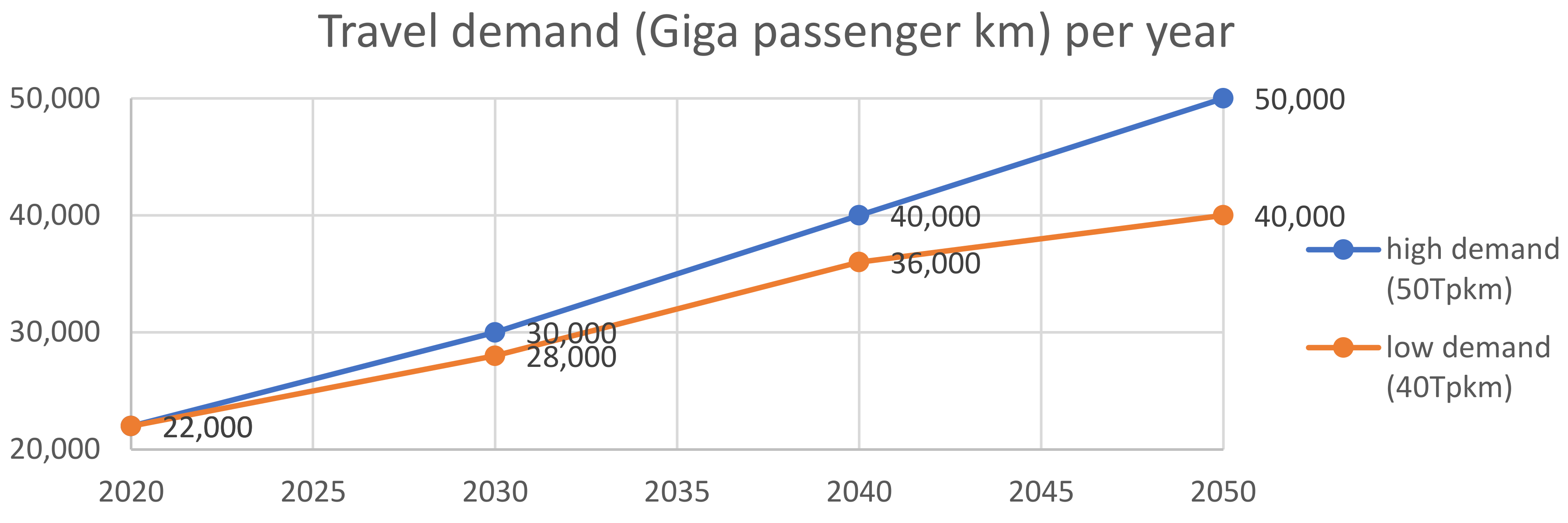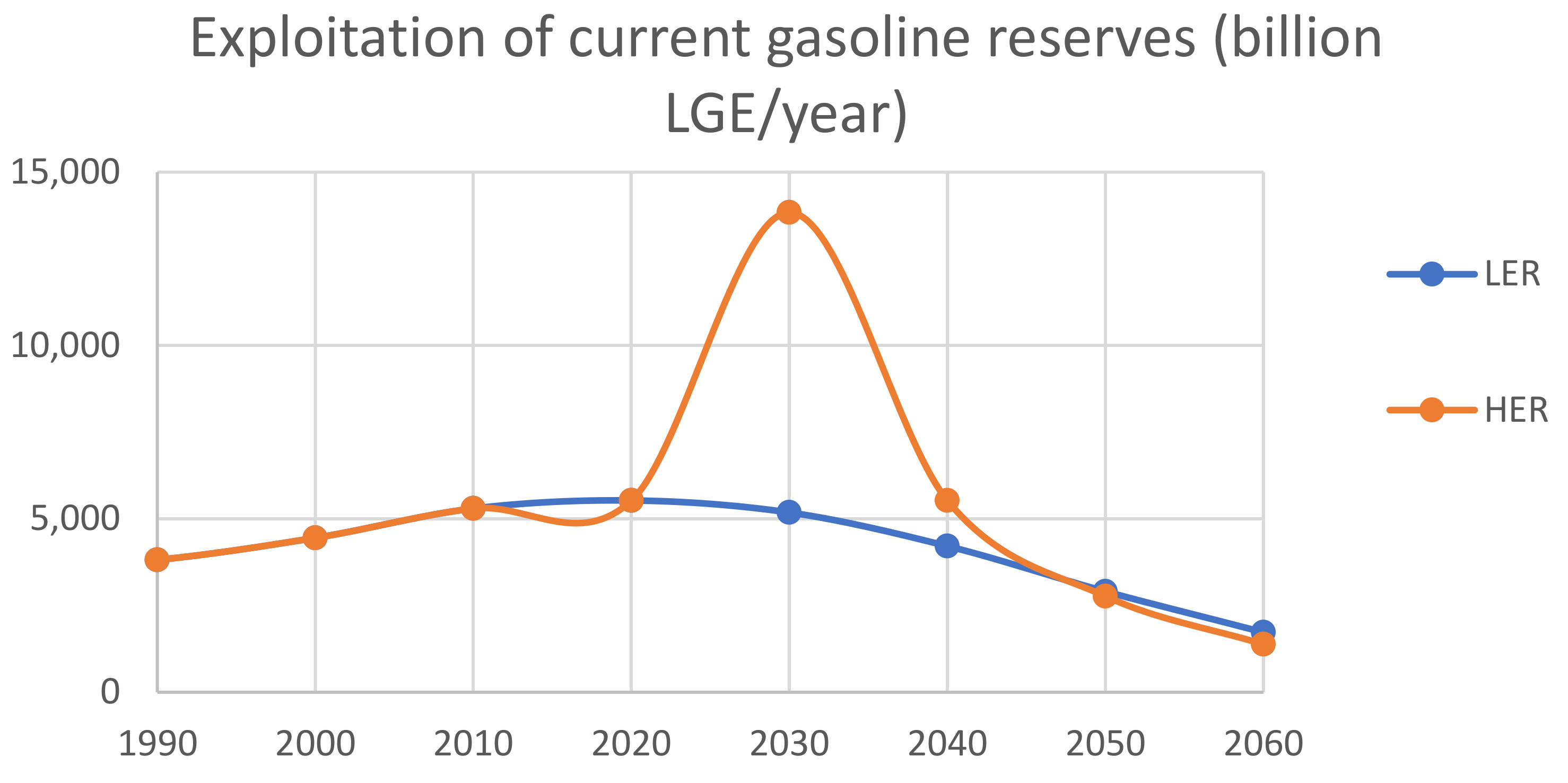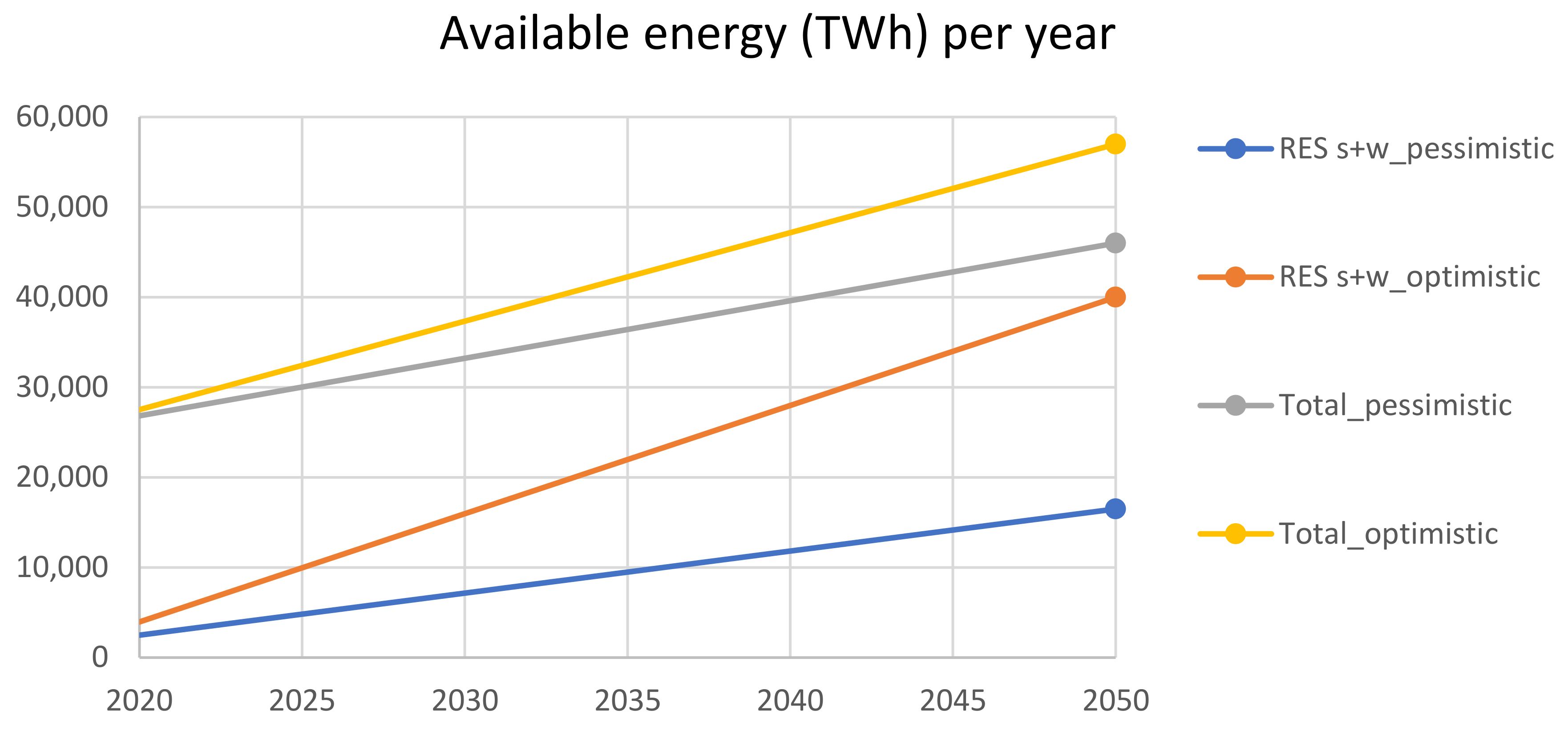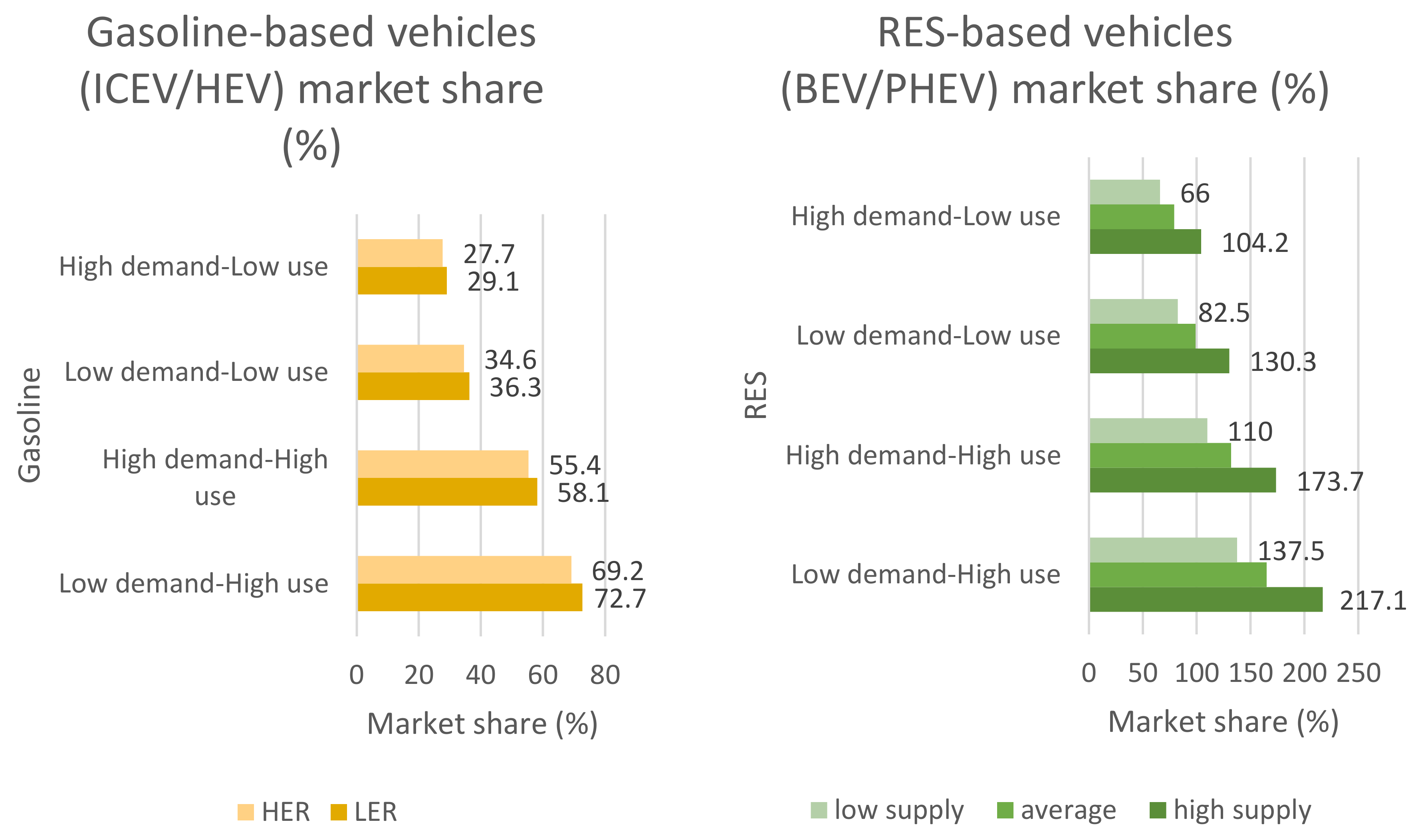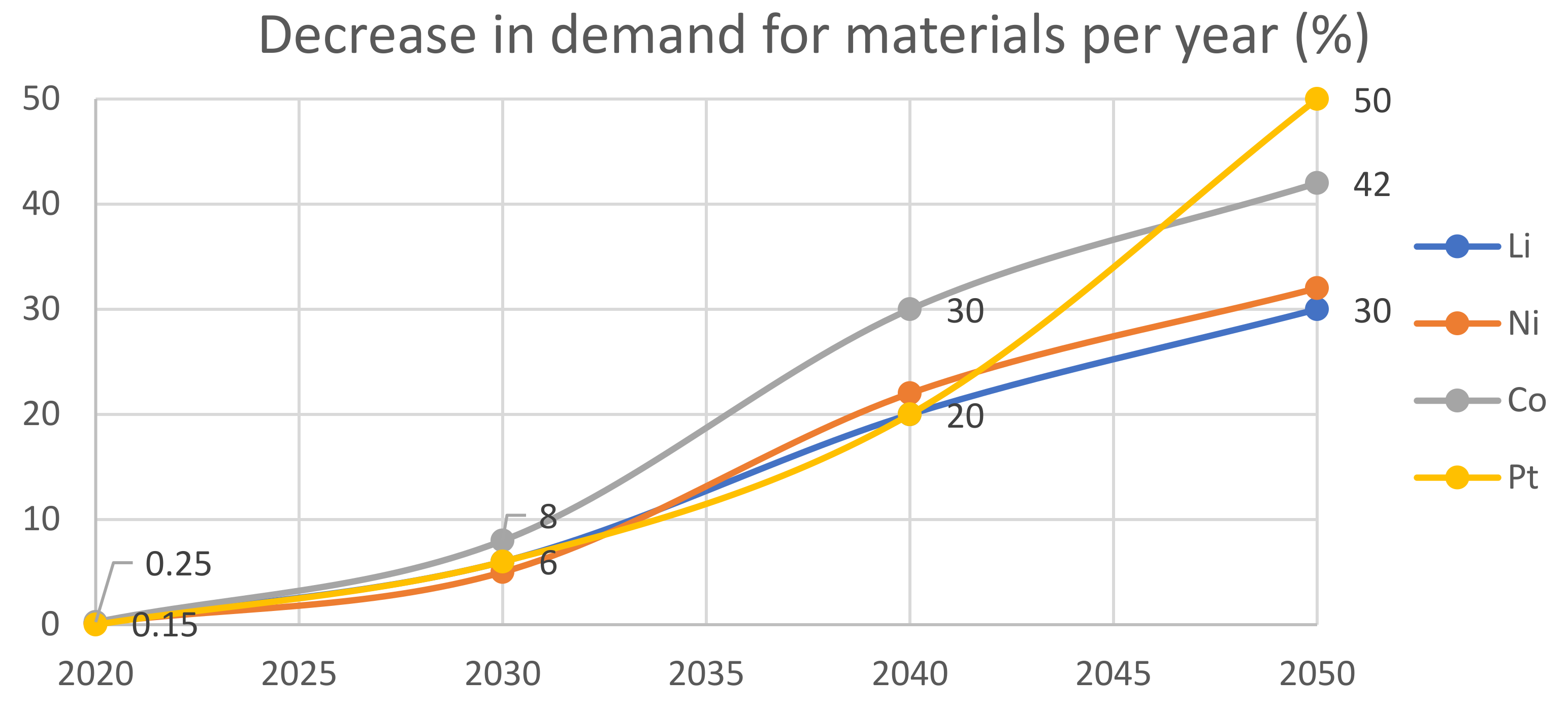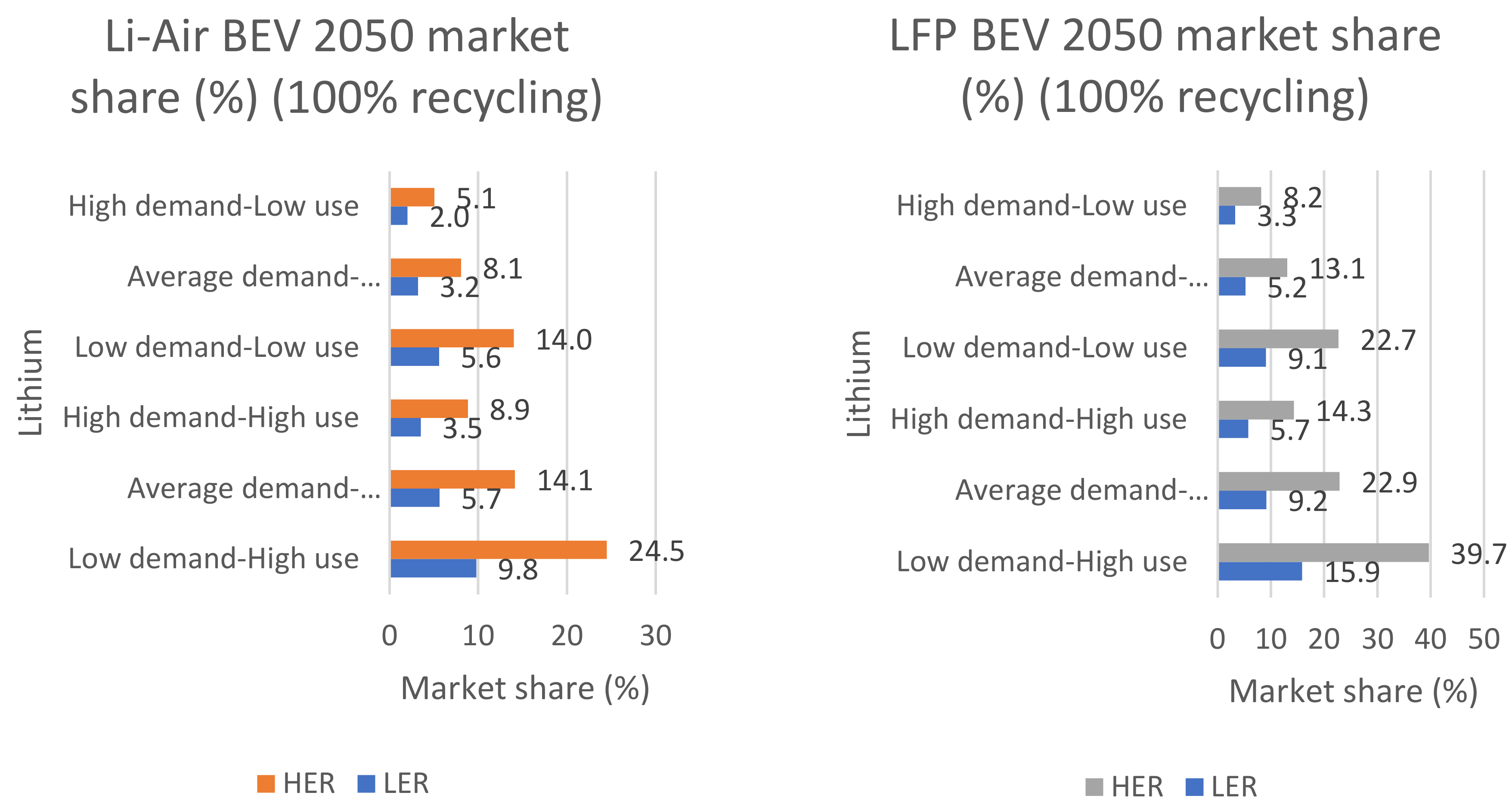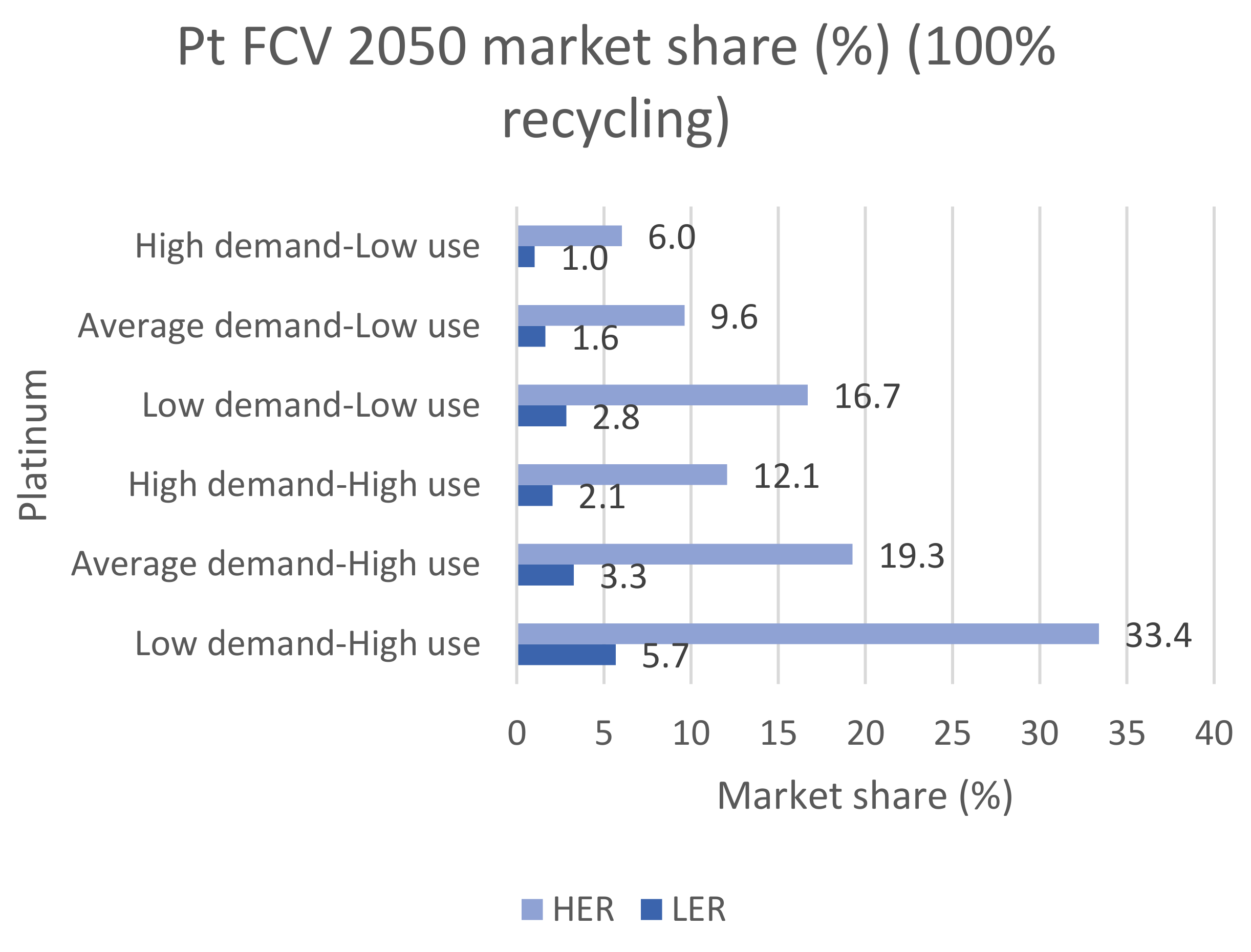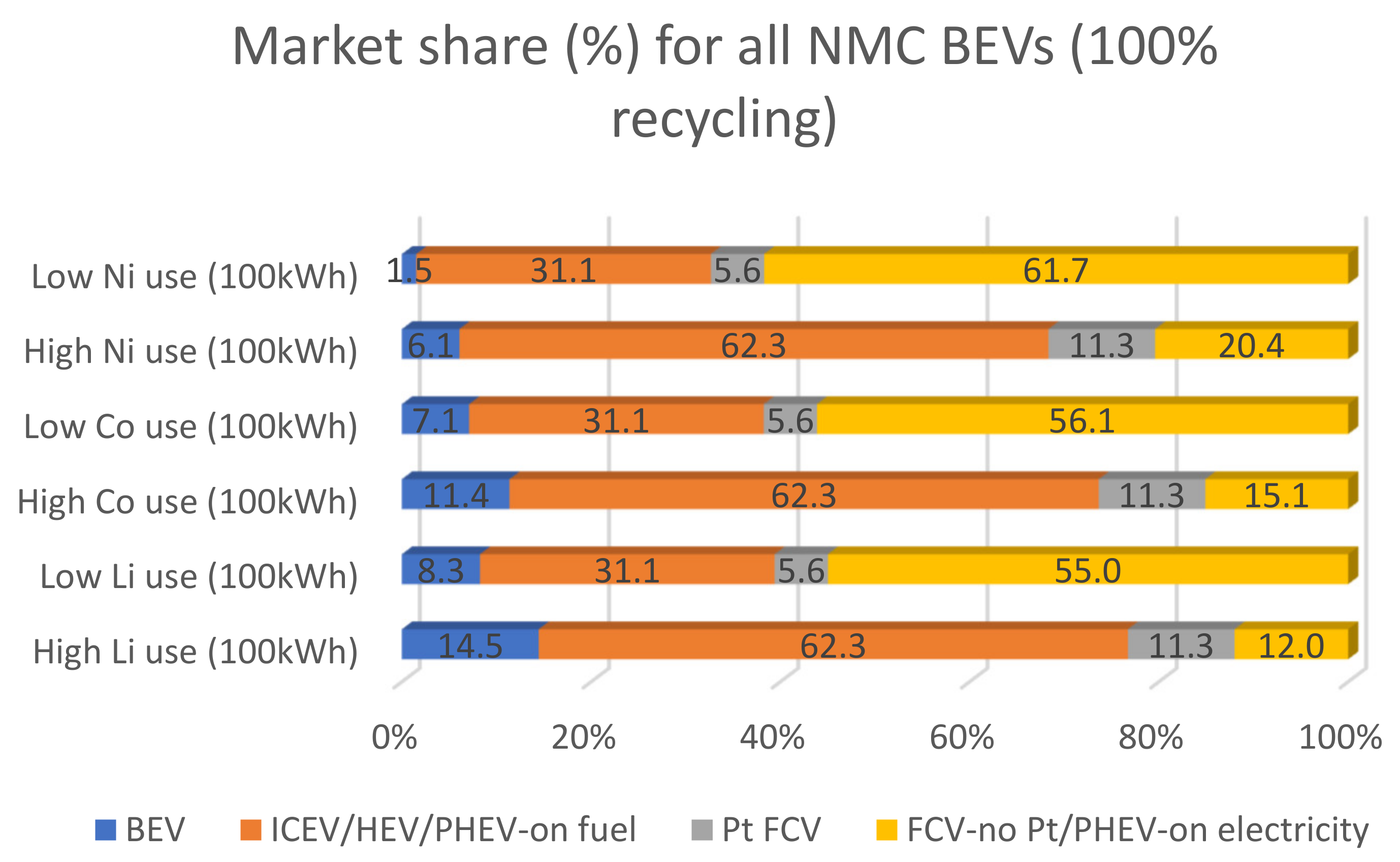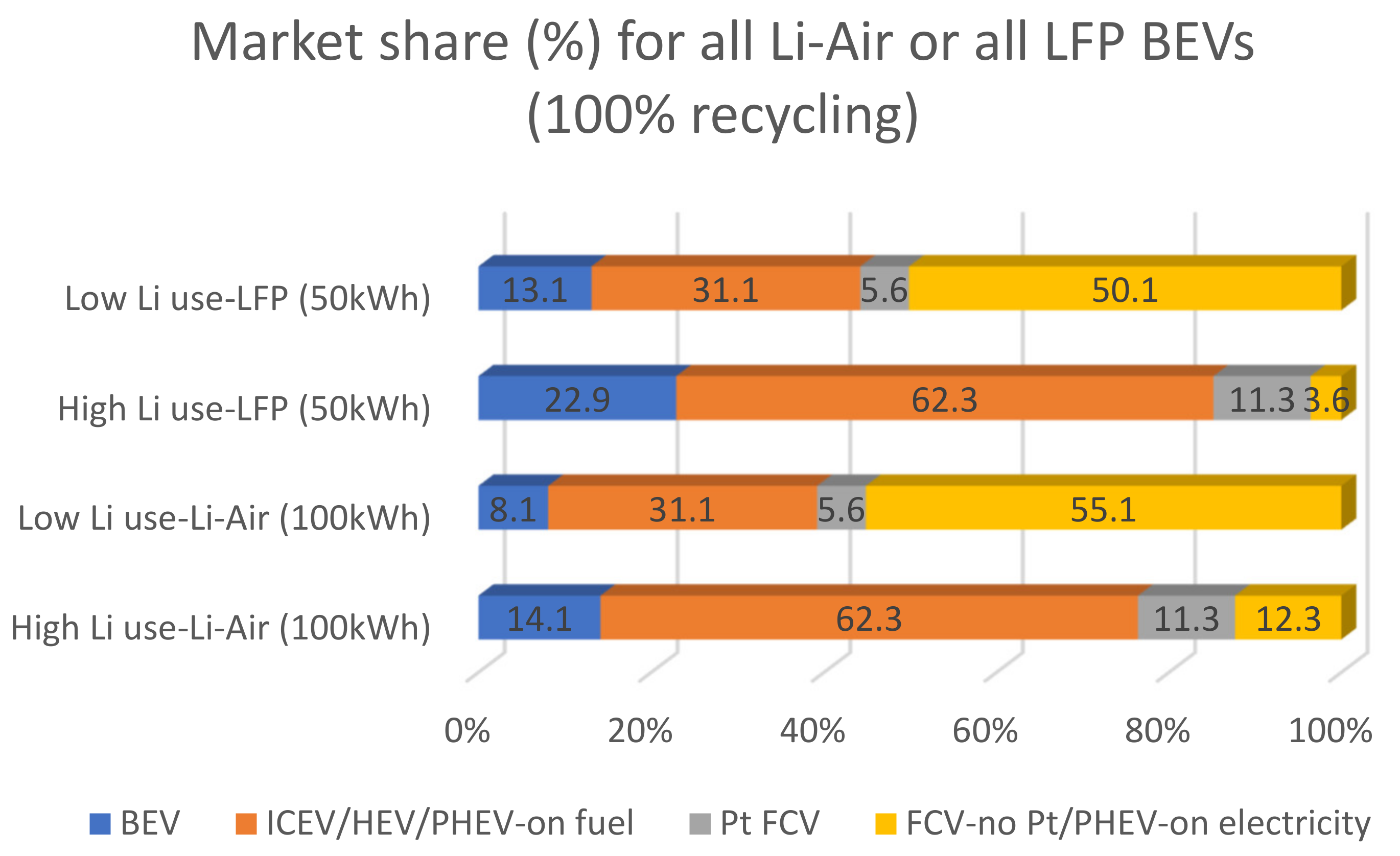1. Introduction
Land transport activities play an essential role within our society. At the same time, these activities generate directly huge amounts of pollutants due to vehicle operation, and indirectly, more pollution due to vehicle production and recycling as well as a significant consumption of energetic resources and raw materials [
1]. A raw image of sustainability for the land transport activities is illustrated in
Figure 1. The land transport market is dominated by light-duty vehicles (LDVs) and will still be until 2050, both in terms of energy use and passenger travel demand [
2]. Powered by the corresponding legislation and specific policies in the automotive sector, various roadmaps, frameworks, models, and life cycle assessment (LCA) studies have been assessed at the European level in order to develop sustainable transport systems [
3,
4,
5,
6,
7,
8]. Their starting point is represented by EU transport reports and statistics [
9,
10]. In such analyses, the medium- and long-term impacts of energy supply and demand balancing and regulations play an important role in shaping the appropriate strategies [
11].
The design of such strategies should tackle the discrepancies between the use of energy and raw materials and the sustainability goals of transport systems in a timely fashion, whether such an approach is event-based, and thus occasional, or is continuous and consequent, based on time sampling. The traditional model for sustainable transport emphasizes mainly three components: Economy, Society, and Environment, as presented in the framework in [
12]. A more simplified model is illustrated in [
13].
The main components of sustainability consist of Energy, Technologies for transport, Resources, the Environment, and the Society/Economy, as seen in
Figure 1. The Energy component includes aspects related to the production and efficiency in the generation and consumption of energy in vehicles. The Transport-related technologies category covers aspects related to the use of better fuels and infrastructure as well as associated implications on transport. The Resources component refers to the demand of raw materials and energy, as well as energy storage issues. The Environment component includes the generation of transport related emissions at each stage and associated impacts on health and environment. The Socio-Economic component covers issues related to the market and its implications on transport. The automotive market is in demand of special policies based on consumer’s behavior. Behavior always plays a significant role. For example, the acceptance of new vehicles such as EVs is many times followed by financial benefits such as incentives, subsidies, pollution taxes, etc.
The resources are split between energy and other raw materials in order to emphasize the essential role played by them in the overall balance of generated pollutants and, of course, on the equilibrium between the efficiency and the utility of the transport activities. For the production loop, the main aspect refers to the technological aspect, as a result of the scientific progress in this particular field. This loop also emphasizes the constraints of the ecologic consequences resulting from the development of transport activities, in synchronism with the demands generated by society. The modulating role of the strategies and policies adopted by society aims to overdrive the natural evolution of the system.
The operation activities are influenced by regulations and the effects on nature and human society. The effects on health and the depletion of natural resources represent the main constraints. The natural resources have a finite character and must be efficiently used during their normal life span and recycled as much as possible after. It also represents at the same time the desiderata of circular economy. Energy is a universal resource, and it is used in the two stages of related activities: infrastructure and operation processes. Energetic resources refer to waste and generation in usage and have important consequences on all sustainability components [
14]. Among the most important are the pollutants and depletion of Earth’s resources. An essential role in this system is played by technologies, as human society’s know-how and capability to provide improved and more efficient transport means, in order to sustain the transport activities, such as their operation, by optimizing the related processes. The operationalization of the transport means will provide services that implement the desired mobility. Both in the case of production and operation of transport means, energy is consumed. Even by considering the energy resources as unlimited, the generation and consumption of energy produces pollution that must be reduced.
The main path to make this possible consists in increasing the energy efficiency in production and operation. The raw materials incorporated in the transport infrastructure will be totally or partially recovered and re-introduced within a new industrial cycle (desiderata of circular economy) [
15]. The society’s effort to satisfy its needs must be feasible and bearable, and this aspect is closely related to the sustainability of related activities. The activities are triggered mainly by the increasing needs of society for transport activities.
Looking back into the car’s history, one can notice how their technological development was correlated with the socio-economic, environmental, and health context, and has paved the way for new policies and strategies for exploiting the available energy sources and materials with respect to the current automotive regulations.
Figure 2 presents the major milestones and impact on energy resources.
The modern vehicle, first developed by Karl Benz in the 1880s, is based on the internal-combustion engine (ICE). The first battery electric vehicles (BEVs), equipped with a DC power system and energized by lead–acid batteries, competed with ICEVs in the 1890s. Electric vehicles (EVs) were less noisy, did not encounter the starting problems of the ICE, and had no tailpipe emissions. In addition, the low range of the BEVs was not considered a problem at that time. In 1901, Ferdinand Porsche invented the first hybrid electric car, the Lohner-Porsche Mixt. Yet, EV sales were to collapse over the next decade, as the manual crank was eliminated by Charles Kettering’s invention of the electric ignition and start. The diesel engine was introduced in 1922 as a more efficient compression–ignition (CI) IC engine compared to the spark–ignition (SI) IC engine fueled by gasoline. Hybrid driving cars made a comeback in 1969 thanks to the GM XP-883 model of General Motors (GM). In 1973, a new hybrid car prototype was proposed due to pollution issues. In 1997, Toyota developed the Prius, which was the first mass production hybrid car.
In the late 1980s, GM decided to develop an all-electric car. One of the reasons was the urban pollution of the American cities, especially Los Angeles. Another reason was the success of the solar-powered Sunraycer electric car in the Solar Challenge race in 1987 [
16]. In recent decades, there have been new vehicle proposals as alternatives to the vehicles mentioned above. Plug-in hybrid electric vehicles (PHEVs) were developed at the end of the 21st century when William H. Patton developed the first hybrid boat propulsion system. The first Fuel Cell vehicle (FCV) was manufactured by GM under the name of Electrovan. Fuel cell vehicles have been commercially available only since 2001 [
17]. In addition, new efforts have aimed to reduce the battery dependency of EVs by using hybrid electric storage systems (HESS). In this regard, the electric storage can be split coherently between supercapacitors (SC) and batteries [
13,
18].
The paper’s motivation consists of the need to highlight the degree of resilience of the evolution mechanism of transport technologies conditioned by the conversion from classical to electric vehicles. The main objective is to obtain herein a holistic picture of this transition. On the one hand, the associated growing needs and the ways in which they can be met are analyzed, and on the other hand, the consequences of the evolution relative to material and energy resources are detailed. In addition, aspects regarding the quality of life (related to caused pollution, impacts on health and ecosystems) and society’s ability to withstand this evolution in terms of economic efficiency and generated added value are presented. The questions to be answered are related to the capacity of the transport system to develop and function as a system capable of permanently balancing supply and demand. The proposed methodology aims to find out mainly the potential space for sustainable evolution of the technological transition of LDVs, from ICE vehicles to electrical cars, by identifying and analyzing the potential scenarios specific to this evolution.
The content of the paper is as follows. After the introduction in
Section 1, which evokes the evolution of the transport domain with the main events, the paper shortly defines the sustainability framework depicted in the next sections. In
Section 2, an overview of the technological progress in the automotive sector is portraited. Such an overview is addressed also in the context of the legislation’s evolution, which is mainly illustrated by EU decisions that could lead to the Green Deal program.
Section 3 includes the proposed methodology that covers the production, operation, and end of life stages, which are typical to a Life Cycle Assessment (LCA) analysis, and compares it other sustainable transport models and frameworks. In
Section 4, two extreme scenarios that forecast the LDV market share in terms of use and balancing of the demand and supply in materials and energy, Low Exploitation Rate (LER) and High Exploitation Rate (HER), are analyzed for one snapshot: 2050. The results are discussed in the final section, which highlights the main findings of this study.
4. Analysis of the Proposed Methodology in Terms of LDV Market Share Outputs
As depicted in the methodology described in
Figure 9, both the predicted number of cars sold and the storage demand in terms of sensitive raw materials can decide the EVs market share. On one hand, population dynamics [
44] and financial status, as seen in
Figure 4, determine the evolution of car sales [
45,
46]. In addition, the increase in Evs acquisition [
47] can model the overall demand depicted in
Figure 10.
On the other hand, such growing demand must be sustained by supplying new resources associated with raw materials and energy. In terms of raw materials, the most sensible to exploitation are lithium (Li), cobalt (Co), nickel (Ni), and platinum (Pt) [
48,
49]. Other sensitive raw materials such as iron (Fe), aluminum (Al), manganese (Mn), copper (Cu), and phosphorous (P) [
41,
49] must be mentioned too, but due to lesser impact on the supply chain, they were not analyzed herein. In addition, the geopolitical context must be taken into account [
14,
48]. United States Geological Studies (USGS) provides an annual report that forecasts the available reserves [
50]. Such predictions for Li [
49,
50,
51,
52,
53], Co [
48,
50], Ni [
50,
54], and Pt [
50] reserves vary from a pessimistic (low supply) to an optimistic forecast (high supply) [
50]. The exploitation of predicted Li reserves follows two main evolutions in
Figure 11: a low exploitation rate (LER) scenario, which is based on [
55] and approximated by a 4th-order polynomial equation, and a high exploitation rate (HER) scenario, which is based on [
23] for Li reserves predictions, as justified in [
49,
56]. These evolutions do not include the recycling potential of raw materials, which will be considered in stage three (end of life).
According to the LER and HER scenarios presented in
Figure 11, if no new Li reserves are found, then these reserves could last until the 2100–2136 period for LER and until 2100–2120 for HER, starting from the pessimistic (low supply) to the optimistic (high supply) predictions. According to the LER [
50,
57] and HER [
23,
50] scenarios presented in
Figure 12, if no new Co reserves are found, then these reserves could last until the 2077–2168 period for LER and until 2080–2120 for HER, starting from the pessimist (low supply) to the optimistic (high supply) predictions.
According to the LER [
23,
58,
59], and HER [
23,
50] scenarios presented in
Figure 13, if no new Ni reserves are found, then these reserves could last until the 2045–2074 period for LER and until 2031–2043 for HER, starting from the pessimist (low supply) to the optimistic (high supply) predictions.
According to the LER [
23,
60,
61] and HER [
23,
50] scenarios presented in
Figure 14, if no new Pt reserves are found, then these reserves could last until the 2129–2149 period for LER and until 2110–2130 for HER, starting from the pessimist (low supply) to the optimistic (high supply) predictions.
Not all Li, Co, Ni, and Pt reserves can be solely used by LDVs, as other applications require also considerable amounts, as seen in
Table 3. Actually, how much of these reserves will be used by LDVs is still very uncertain. Various studies try to give some insights on how much of the Li [
62,
63,
64,
65,
66], Co [
63,
67,
68], Ni [
69,
70], and Pt [
71,
72] reserves can be used by cars. These predictions are synthesized in
Table 3.
In addition to the supply chain issues caused by the manner in which the sensitive raw materials are exploited, other issues associated with the storage demand of cars affected by battery chemistry and capacity constraints are just as relevant, especially in the case of EVs. NMC/NCM, NCA, LFP, and Pt-based batteries are already technologically available, while the same cannot be said about Li-based batteries such as Li-S and Li-Air. Starting from the battery chemistry, it is possible to determine the need in sensitive raw materials. This depends also on the car storage capacity in case of EVs and is highlighted in
Table 4. These values can be approximated to the ones found in [
49,
73,
74,
75]. Most BEVs have a battery size that varies from 50 to 100 kWh [
62,
76]. Due to the higher energy densities of NMC and NCA batteries compared to the much lower density of LFP, as seen in [
62], LFP will be solely used for lower battery size BEVs such as 50 kWh. In addition, new battery chemistries based on Li-S and Li-Air [
77] can satisfy the higher energy demand of BEVs with 100 kWh battery size. Starting from the methodology presented in
Figure 9, the authors analyze how the market share can respond to the raw materials constraints at stage one (production) and stage three (end of life) and energy constraints at stage two (operation).
The demand in raw materials is correlated with the storage constraints, and by consulting
Table 3, NMC/NCM and Li-Air battery chemistries are analyzed herein for use in 100 kWh BEVs, while LFP is analyzed for 50 kWh BEVs. Stage one (production) does not take into consideration the recycling potential associated with stage three (end of life, with 100% recycling). Yet, the no-recycling tag seen in
Figure 15,
Figure 16 and
Figure 17 does not mean that the EV’s batteries cannot be used at the end of their service life. Second life applications are possible as long as the lower battery capacity (70–80% from the initial capacity) can satisfy the application’s requirements. The market share that results from the supply/demand calculations is presented in
Figure 15 and
Figure 16 for 100 kWh BEVs and in
Figure 17 for 50 kWh BEVs and Pt-based FCVs.
Stage two (operation) deals with energy constraints in terms of gasoline reserves for ICEVs, HEVs, and PHEVs running on gasoline (high travel autonomy) and of available renewable energy (RES) for charging BEVs and PHEVs running on stored energy in batteries (low to medium travel autonomy). The starting point represents the predicted travel demand in passenger km [
2,
78], as depicted in
Figure 18.
By applying a similar evolution to the one in
Figure 11,
Figure 12,
Figure 13 and
Figure 14, the gasoline consumption per year in liters per gasoline equivalent (LGE) follows two evolution curves by 2060, in
Figure 19, that aim to reduce the current high consumption of ICEVs and HEVs, which is 5535 billion LGE [
79] to around 30% (1600 billion LGE) for a LER prediction, based on [
25], which means that current reserves can last up to around 70 years until they run out, and for a HER prediction, based on [
24], which means that current reserves can last to around 40 years. Other fuels such as bioethanol, diesel, CNG, and hydrogen are analyzed in terms of demand in [
41].
Since not all the gasoline can be used to fuel LDVs, the predictions for gasoline use in cars can vary from 20% (low use) to 40% (high use) according to various studies [
80,
81,
82]. How much clean energy is available for charging EVs is depicted in
Figure 20, according to [
83,
84,
85] for optimistic (high supply) and pessimistic (low supply) predictions, as well as the total energy available predicted by 2050.
The resulting market share for gasoline dependent LDVs is depicted in
Figure 21.
Assuming only clean energy (RES) is used for charging EVs, the market share is also determined in
Figure 21 for EVs based on supply/demand calculations for the two use scenarios, according to [
86,
87].
Stage three (end of life) takes into consideration the recycling potential of the raw materials discussed in stage one, according to [
77]. The predicted decrease in materials is presented in
Figure 22. The adjusted market share is presented in
Figure 23 and
Figure 24 for Li and Pt reserves. In addition to the raw materials mentioned in the production stage, such as Li, Co, Ni, Mn, Al, and Cu [
41,
49], which are all candidates for the recycling stage, also silicon (Si) and graphite must be considered for this final stage, as depicted in [
71].
After the three stages, by considering an average supply/demand ratio, the market share for all LDV types is depicted in
Figure 25 for NMC-based BEVs with a capacity of 100 kWh and in
Figure 26 for Li-Air-based BEVs with a capacity of 100 kWh and for LFP-based BEVs with a capacity of 50 kWh, for the two use scenarios.
As seen in
Figure 25, the high use case follows the more conservative scenario, which is comparable to the ones in
Figure 8, while the low use case follows the more progressive scenario in
Figure 8, leaving the door open for non-platinum FCVs and lower battery capacity EVs. As seen in
Figure 21, charging EVs is not an issue in terms of RES demand, since it is unlikely that their market share will exceed 66%.
As seen in
Figure 26, the high use case follows the more conservative scenario which is comparable to the ones in
Figure 8, while the low-use case follows the more progressive scenario in
Figure 8, leaving the door open for non-platinum FCVs and lower battery capacity EVs. For meeting the Stated Policies (STEP) requirements (25% market share for BEVs), it is imperative to decrease the storage capacity. As seen also in
Figure 26, only LFP-based BEVs can get near to such requirements. In the high use case, the market share follows a more likely conservative scenario, while in the low use case, the progressive scenario is more noticeable.
The LDV market share outputs are synthesized in
Table 5,
Table 6 and
Table 7 for the three main scenarios: worst-case scenarios for BEVs (BEV WCS), average supply/demand scenarios, and best-case scenarios (BEV BCS). WCS refers to a minimum value of the supply–demand ratio, thus for low supply and high demand, and it usually refers to a LER evolution. BCS refers to a maximum value of the supply–demand ratio, thus for high supply and low demand, and it usually refers to a HER evolution, especially for the optimistic case.
5. Conclusions and Future Challenges
Overall, this paper provides a holistic image of the transport domain, especially LDVs, in the context of the depletion of raw materials, the growing energy prices, and pollution with major consequences on the sustainable development of society. The rationale of this study consists of addressing the question of whether the society is capable of assuring a smooth transition from the ICE-endowed vehicles to the fully electric transport, which is said to represent a more clean and efficient solution for solving the problem of mobility of people and goods. The implications on environment and implicitly on health at each stage are reiterated in [
1,
3,
4,
5,
6,
7,
8,
9,
10,
11,
27,
28,
29,
30,
31,
32,
33,
34,
35,
36,
37,
38,
39,
40,
41,
88].
As shown in the previous section, STEP scenarios are only possible if the best-case scenarios for BEVs (BEV BCS) are feasible, which leads to the assumption that the supply–demand ratio is kept at maximum. The implications on the Li, Co, and Ni supply chains are major, meaning that the depletion of materials could not be covered if no new reserves are discovered. The worst-case scenarios for BEVs (BEV WCS) are the most sustainable from the supply chain’s point of view. However, by keeping the exploitation of supply at minimum, the low market share of BEVs would leave the door largely open for FCVs and PHEVs. At the moment, these are far away from being deployed due to infrastructure and market issues. Therefore, the best compromise is found in the average supply/demand scenarios. Regarding SD scenarios, even if the reserves of sensitive raw materials could double by 2050, there is no guarantee that their exploitation rate would follow a similar evolution. One of the main reasons refers to the geopolitical context associated with the mining of those resources.
The results of this study show that battery chemistry and storage capacity play a primary role in determining the LDV’s powertrain market share as well as the usage of materials and energy in electric energy storage systems (EESS).
The current study does not target all research efforts in the field of EESS nor does it analyze hybrid systems (batteries and supercapacitors or batteries, supercapacitors, and fuel cells) that will be able to prove themselves as reliable solutions in the near future, with improved reliability in the field of transport. In addition, the role of the correlation between the development of RES and EESS is not detailed herein. This will play an extremely important role in the future of this field. The need for a comprehensive analysis in this sense is justified in [
1,
2,
3,
4,
5,
6,
7,
8,
9,
10,
11,
12,
14,
15,
16,
17,
18,
19,
20,
26,
27,
42,
43,
86,
87,
88,
89].
The article once again reiterates the need to form a forward-looking image of transport systems and highlights the possible limits that the associated activities generate in correlation with the technological developments in the field of transport and the depletion of raw materials and energy reserves. The consequences for the evolution of ecosystems in general are revealed. The proposed methodology ensures a framing of this evolution with clear implications in obtaining a certain degree of sustainability for the investigated process.
